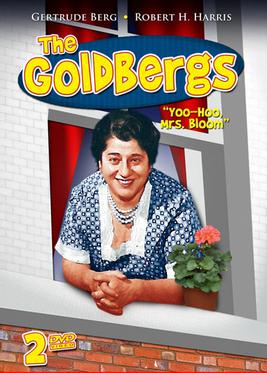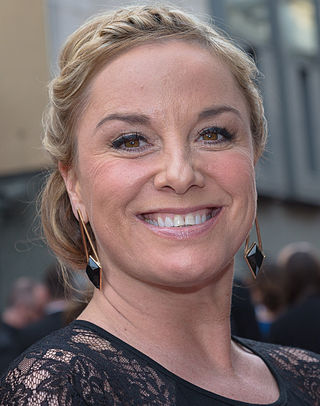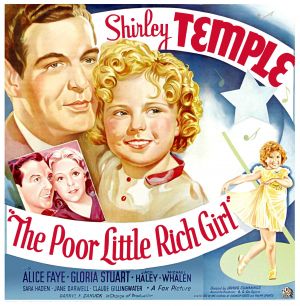
The Goldbergs is a comedy-drama broadcast from 1929 to 1946 on American radio, and from 1949 to 1956 on American television. It was adapted into a 1948 play, Me and Molly; a 1950 film The Goldbergs, and a 1973 Broadway musical, Molly. It also briefly spun off a comic strip from June 8, 1944, to December 21, 1945, with art by Irwin Hasen, a comic book artist who worked on various DC Comics titles and would later do the Dondi comic strip.

Jackson Beck was an American actor best known as the announcer on radio's The Adventures of Superman and the voice of Bluto in the Famous era Popeye theatrical shorts.

Donna Mills is an American actress. She began her television career in 1966 with a recurring role on The Secret Storm, and in the same year appeared on Broadway in Woody Allen's comedy Don't Drink the Water. She made her film debut the next year in The Incident. She then starred for three years on the soap opera Love is a Many Splendored Thing (1967–70), before starring as Tobie Williams, the girlfriend of Clint Eastwood's character in the 1971 cult thriller Play Misty for Me. Mills played the female lead in the heist film Murph the Surf (1975), and had starring roles in a number of made-for-television movies during the 1970s.

Larry Haines was an American actor.

Josephine "Joan" Davis was an American comedic actress whose career spanned vaudeville, film, radio, and television. Remembered best for the 1950s television comedy I Married Joan, Davis had a successful earlier career as a screen actress, and a leading star of 1940s radio comedy.

Tamzin Maria Outhwaite is an English actress, presenter and narrator. Since playing the role of Mel Owen in the BBC soap opera EastEnders, she has starred in a number of theatre and television productions, including army series Red Cap and crime drama New Tricks.

Helen Mack was an American actress. She started her career as a child actress in silent films, moving to Broadway plays and touring one of the vaudeville circuits. Her greater success as an actress was as a leading lady in the 1930s. She made the transition to performing on radio and then into writing, directing, and producing shows during the Golden Age of Radio. She later wrote for Broadway, stage and television. Her career spanned the infancy of the motion picture industry, the beginnings of Broadway, the final days of vaudeville, the transition to sound movies, the Golden Age of Radio, and the rise of television.

Charles Byron Griffith was an American screenwriter, actor, and film director. He was the son of Donna Dameral, radio star of Myrt and Marge, along with Charles' grandmother, Myrtle Vail, and was best known for writing Roger Corman productions such as A Bucket of Blood (1959), The Little Shop of Horrors (1960), and Death Race 2000 (1975).

Myrtle Vail, sometimes credited as Myrtle Damerel, was an American vaudevillian, and radio and film actress and writer. She was a radio fixture from 1932 to 1946 thanks to the popular soap opera Myrt and Marge, playing the elder half of the title as well as having created and written the show.

Dorothy Lee was an American actress and comedian during the 1930s. She appeared in 28 films, usually appearing alongside the comedy team of Bert Wheeler and Robert Woolsey.
Albert Isaac Boasberg was an American comedy writer in vaudeville, radio, and film, as well as being a film director.

Poor Little Rich Girl, advertised as The Poor Little Rich Girl, is a 1936 American musical film directed by Irving Cummings and starring Shirley Temple, Alice Faye and Jack Haley. The screenplay by Sam Hellman, Gladys Lehman, and Harry Tugend was based on stories by Eleanor Gates and Ralph Spence, and the 1917 Mary Pickford vehicle of the same name. The film focuses on a child (Temple) neglected by her rich and busy father. She meets two vaudeville performers and becomes a radio singing star. The film received a lukewarm critical reception from The New York Times.

Myrt and Marge is a 1933 American pre-Code Universal Studios feature film, starring Myrtle Vail and Donna Damerel. The film is noteworthy today because it co-stars Ted Healy and his Stooges, shortly before the trio split from him and became the Three Stooges. The team included Bonnie Bonnell, who was a short-lived female Stooge.
Gang Busters is an American dramatic radio program heralded as "the only national program that brings you authentic police case histories." It premiered on January 15, 1936, and was broadcast over 21 years through November 27, 1957.

Beau Ideal is a 1931 American pre-Code adventure film directed by Herbert Brenon and released by RKO Radio Pictures. The film was based on the 1927 adventure novel Beau Ideal by P. C. Wren, the third novel in a series of five novels based around the same characters. Brenon had directed the first in the series, Beau Geste, which was a very successful silent film in 1926. The screenplay was adapted from Wren's novel by Paul Schofield, who had also written the screenplay for the 1926 Beau Geste, with contributions from Elizabeth Meehan and Marie Halvey.

Gene Autry's Melody Ranch is a Western variety radio show in the United States. A 15-minute pilot show aired on December 31, 1939. The program ran from January 7, 1940 to August 1, 1943, and from September 23, 1945 to May 16, 1956. The show's entire run was broadcast over the CBS radio network, sponsored by Doublemint gum. The approximately two-year interruption resulted from Autry's enlistment in the United States Army to serve in World War II. Initially titled Doublemint's Melody Ranch, the show's name was changed to Gene Autry's Melody Ranch in early 1941. Episodes were 30 minutes long except for a 15-minute version that ran from September 23, 1945 to June 16, 1946. The theme song was "Back in the Saddle Again".

Matt Crowley was an American film, television and radio actor.
Doc Barclay's Daughters is an American old-time radio soap opera. It was broadcast on CBS from January 23, 1939, to January 19, 1940.

Donna Damerel was an American actress.
















